In an interview, while reminiscing about his first few years in the Hindi cinema industry, Naushad mentioned how, after he had moved to Bombay and become a music director, his parents arranged his wedding. “We have told your future in-laws that you are a tailor,” his mother said. “If we’d said you were into music, you’d never have gotten married!” The irony of the whole thing was, recalled Naushad, that at the wedding, the band that came along was playing all the latest hits – all of which happened to be from Naushad’s first big score.
Which, as you’ve probably guessed by now, was from this film. Naushad came to Bombay from Lucknow in 1937, and though he did get some work over the next few years, it was not until Rattan that he got a chance to compose the sort of music that catapulted him to the top.
The music of Rattan was the main reason I wanted to see this film. Other than that, I wasn’t especially keen on the film – not inimical to it, but not terribly enthusiastic about it, either.
A few minutes into the film, and I began liking it a lot. The acting is generally good, the dialogue and the story don’t feel dated, and there’s a lot about it that’s very likeable.
The two main characters of the film are Gauri (Swarnlata) and Govind (Karan Dewan). Gauri and Govind live in a village and have been playmates since they were children. Even now that they’ve grown up, they’re the best of friends, with Gauri constantly pulling Govind’s leg, gobbling up the parathas his mother’s made for him, and teasing him. It’s obvious that they’re in love, but not in the syrupy soppy way that seems to be so common in old Hindi films. (Point #1 scored in favour of Rattan!)
Point #2 comes soon after, with one of my favourite songs from this film, Akhiyaan milaake jiya bharmaake chale nahin jaana.
The entire village knows about Gauri and Govind’s romance, though except for a couple of interfering old hags, nobody seems to mind much. This, despite the fact that Govind is a bania while Gauri is a Rajput—in other words, they’re from different castes.
One of the interfering old hags is a woman called Gangu. Gangu has been telling Gauri’s mother (Amir Banu) that now that Gauri has grown up, it’s not seemly for her to be gallivanting around the village with Govind. Gauri’s mother, therefore, ticks Gauri off too.
Govind’s mother (?) is, similarly, not in favour of Govind harbouring any sort of affection for Gauri. She tries repeatedly to tell her husband (Badri Prasad) to check his son, but all to no avail. Govind’s father is a laidback man, who isn’t particularly perturbed by Govind’s friendship with Gauri, or by the fact that Govind, despite being now an adult, doesn’t do much to help his father with their small business.
One somewhat unusual relationship (at least for 40s’ Hindi cinema) here is that of Govind’s parents. He keeps teasing his wife that his marrying her broke the heart of a girl who had long been in love with him. His wife, when teased, immediately grabs her bundle of clothes and threatens to go off to stay with her brother. And whenever she makes that threat, her husband says that since she will leave his home, he will leave too and go off to spend the rest of his days on the banks of the Ganga, where he’ll die – and as soon as he mentions dying, she quickly bustles over, shutting him up, and they hug and make up. Rather cute.
Into this idyllic story Gangu (Who is this actress? I know I’ve seen an older version of her in a lot of films from the 50s and 60s, but I don’t know her name) now throws a spanner in the works. She comes to Gauri’s mother with a proposal for Gauri. The proposed groom is Gangu’s own brother Rattan (Wasti, whom, if you are more familiar with films from the 50s and 60s, you may have seen in Dil Deke Dekho and Phir Wohi Dil Laaya Hoon). Rattan is an editor (with a publishing house, it appears). He is also a widower with a 10-month old baby daughter.
Gauri’s mother, far from consulting Gauri, doesn’t even inform her until it’s time for Gauri’s engagement. A wink and a blink, and before we know it (before even Gauri knows it), she’s married to Rattan and is being helped into the palki which will take her to her husband’s home. Poor Govind is devastated. He manages to smuggle a note to Gauri, and having read his declarations of undying love in the face of her faithlessness, Gauri is reduced to tears as she jolts along in the palki.
Rattan lives in a fashionable house in town, along with his college-going sister Manju (? Manju? Thank you, Mister Jinx, for identifying this actress! Mister Jinx also mentions that she and Karan Dewan met while filming Rattan, and later got married) and his widowed bhabhi (?). The bhabhi has no children of her own, so spends all her time poking her nose into matters that don’t concern her. She isn’t a bad soul, but a busybody who soon makes it her business to ensure that Rattan appreciates what a pretty wife he’s managed to get.
Unfortunately for the bhabhi (and for Gangu, who had given Rattan to understand that the bride she has chosen for him is 28 years old, really long in the tooth and vegetating up there on the shelf!) – Rattan is shattered when he catches a glimpse of Gauri’s face. This is a beautiful young girl, he realises. A mere teenager, not a raggedy old spinster who’d never have got married if it hadn’t been for him.
And now he, Rattan, already a father and a widower more than double Gauri’s age, has tied her to him, ruining her life. He’s eaten up by remorse, and doesn’t know what to do. (A refreshingly un-MCPish attitude for that period and place). At any rate, he decides that he will not consummate the marriage. He can’t; he’ll feel too guilty about it.
Rattan’s resolve is further strengthened by the sudden arrival of an unsolicited manuscript which a writer has sent him. The book, which is named Pati-Patni (Husband-Wife), has been written from the point of view of a 16-year old girl married to a 55-year old man. As Rattan reads aloud through the book, the plight of the young bride – and, by extension, Gauri – becomes more and more heart-rending.
(Oddly enough, in real life Swarnlata fell in love with, and married, an actor named Nazir, who was 20 years older than her).
Meanwhile, back in the village, poor heart-broken Govind has been wandering around in a daze. One day, just before Diwali, Gauri’s mother happens to visit Govind’s father’s shop, to ask if there’s any chance of Govind going to the town to run any errands. When it emerges that Govind does have to go to town to buy some silver coins for the Diwali pooja, Gauri’s mother asks him for a favour: she gives him some money and requests him to buy sweets and drop them off at Gauri’s home.
Gauri’s mother is obviously not the most sensitive of people.
Govind, obedient young man that he is, does turn up at Gauri’s home on Diwali, carrying the sweets he’s bought on her mother’s behalf. His meeting with Gauri threatens to be very awkward, but Rattan’s bhabhi, completely oblivious to the undercurrents right before her very eyes, tides it over. She forces Govind to sit, to partake of some sweets, and to watch a song-and-dance performance that is being staged at their home.
Both Govind and Gauri are painfully aware of each other’s presence, and also of the fact that they shouldn’t be, what with Gauri being married to Rattan.
But the bhabhi hasn’t finished yet. It’s late at night, she says; Govind cannot possibly start out for the village so late; he must stay the night at their home.
In the middle of the night, Govind, unable to control his emotions any longer, comes to talk to Gauri, and to reassure her that he will always love her. A distressed Gauri begs him not to try and see her again; she is, after all, a married woman now.
It is all very upsetting, what with Gauri and Govind pining for each other, while Rattan is having a hard time staying away from his lawfully wedded wife. Where will this impasse end?
What I liked about this film:
The music. Oh, the music. Naushad, in an interview, said that ever since he had begun composing music for Hindi cinema, he had been hoping for a chance to compose songs based on folk tunes from Uttar Pradesh, which he was particularly fond of. Rattan gave him that opportunity, and he used it to the fullest. This film has some awesome songs; my favourites are Akhiyaan milaake jiya bharmaake chale nahin jaana; Jab tumhi chale pardes lagaakar thes; and the lilting O jaanewaale baalamwa lautke aa lautke aa.
The refreshingly undated feel of the film. For a film that was made in 1944 (a period that seemed to be dominated by theatrical acting and some pretty chauvinistic ideas), Rattan was surprisingly modern in some ways – for instance, in the relationships between Gauri and Govind, or between Govind’s parents – and Rattan was a most unusual husband.
What I didn’t like:
Spoiler ahead:
The end. My goodness, if I’d known it was going to be this tragic, I’d probably never have watched the film.
Spoiler ends.
The problem with Rattan is that while it’s cheery, even light-hearted in the first half and interesting (not yet depressing) in the third quarter, by the last 20 minutes or so of the film, it turns woefully melodramatic and tragic. The melodrama isn’t as painful as in some films I’ve seen; but the sorrow that engulfs the lives of these people hit me even harder because the film had started off being so much fun.

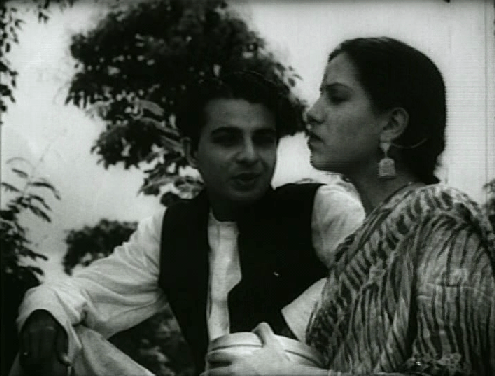

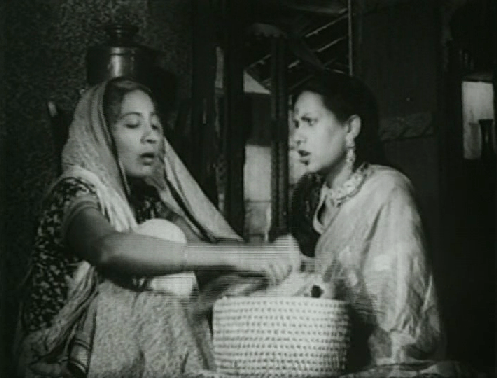

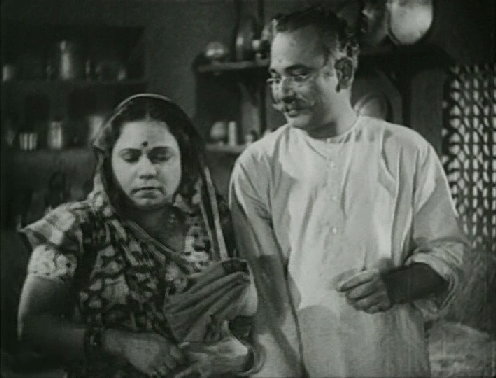

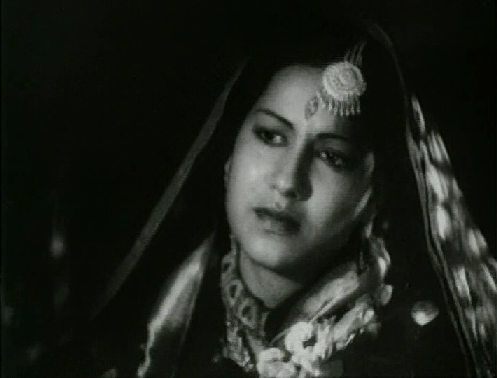


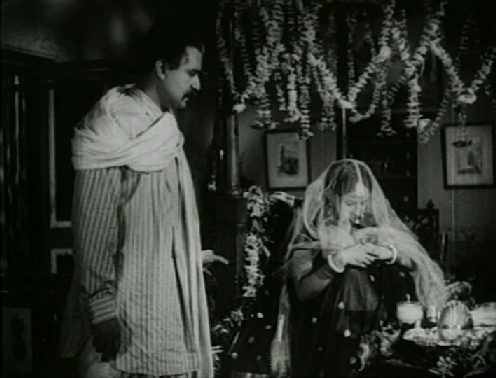
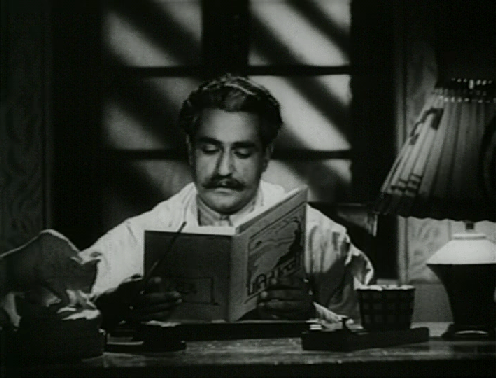
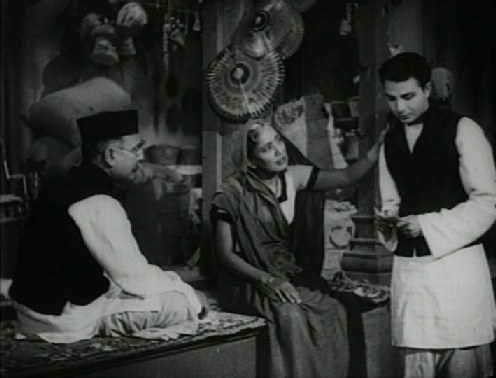
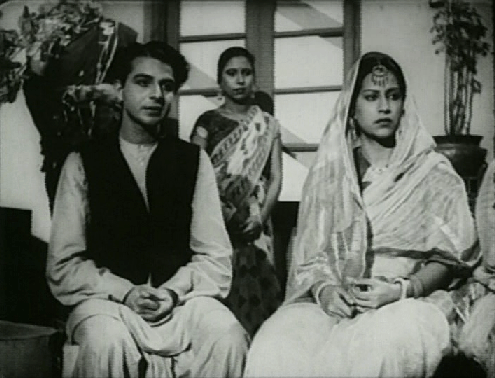
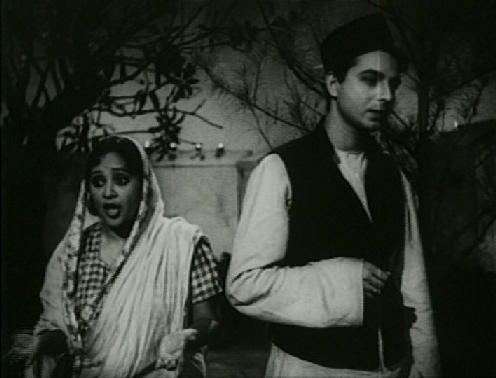
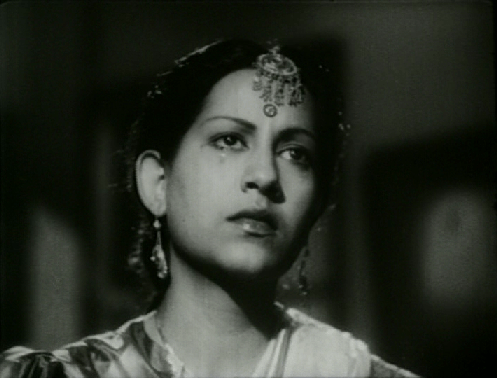
I must say this film makes even the modern day dramas look regressive …. at least the parts you have described :-)
Is the ending regressive or only sad?
LikeLike
Yes, I was pleasantly surprised by how progressive this film was – that the older husband should have thought his young wife was wronged, was a very welcome change from even later films like Suhagan (which basically said that a married woman has no business having any interests outside home and husband) or the excruciating Chandan ka Palna. Less said about that, the better.
The end is just very sad, not regressive. In fact, there’s a very progressive aspect to it, which I hadn’t expected.
LikeLike
I’ve had this DVD for a while, and never got down to watching it. But you’ve written it up so well. As for the melodramatic ending, I assume it is because all said and done, marriage is for keeps, in Indian cinema, isn’t it?
LikeLike
Yes, I guess Hindi cinema does go with the ‘marriage is for keeps’ premise; but then I’ve also seen a fair number of films which stick with the ‘love is for keeps’ premise – if you’ve fallen in love with someone really deeply, you can only ever be his/hers. And Rattan has the unenviable task of having to choose – should it be marriage, or should it be love? Which is why the end is so tragic.
LikeLike
Dustedoff, I agree regarding your likes and dislikes here… Though from the bunch of films I’ve seen, I don’t think it’s that unusual for a movie from the ’40s or early ’50s which seems relatively cheerful in the beginning to end up in gloom and doom. (But actually, I kind of like that sometimes…)
The soundtrack is one of my absolute favorites. This was a great year for Hindi film music. (Between this, Dost, Lal Haveli, Daasi… Wow. The ’40s were the best! :) )
I like Swaranlata too. I didn’t know what had happened to her in later years until I started looking at Pakistani films and film clips from the 1950s and ’60s. I did that to follow Noor Jehan, and then I saw that Swaranlata was popping up a lot too…
———————–
P.S. I found a better/clearer copy of that great dance to O Janewale Balamwa here . There’s another dance, in Sanjog (1943, also Naushad), that reminds me a little of this one. I was already planning to do some kind of post about that when I saw your review today. :)
LikeLike
Richard, did you actually get around to seeing any of the films that Swarnlata made in Pakistan? I would welcome recommendations, if you have any to offer!
The copy of O jaanewaale baalamwa that you linked to is pretty similar to the DVD I had (borrowed from my Dad) – as far as quality is concerned. The DVD I watched was also a Friends one, though (very surprisingly) there was no onscreen logo. :-) I’m off to read your post now…
LikeLike
Did I actually get to see the films? Uh… Probably not. :) If you’d asked me that about Noor Jehan, I could tell you that I saw at least half a dozen of her Pakistani films, most of them without understanding the words because there were no subtitles – and not really caring about that. :) But with Swaranlata, it was more a matter of finding her repeatedly as I was looking through song clips.
There actually are a few good articles about her and her career in India nad Paksitan. If you do a search, you’ll find them quickly. :) Among the movies that she’s done, I think Naukar (1955) looks good (though the script is said to have been “plagiarized” from the Indian film Aulad (1954)) and I’d also like to see Heer (also 1955).
Regarding that new post… Oops, haven’t done it yet. But if you didn’t find it this time, you should soon.
LikeLike
Yes, I did discover that the post wasn’t up – but I will be checking back frequently. :-)
I saw a mention of Naukar on cineplot, I think, as one of Swarnlata’s best Pakistani films. Will look out for that. Thank you for recommending that and Heer (and for warning me about Naukar being possibly ‘plagiarized’!)
LikeLike
I have seen Naukar. It was a golden jubilee hit film, and was quite watchable (if I remember correctly), but then it was a plagiarized version of Indian film. I read somewhere in old Mag that the scriptwriter of the Indian film Aulad A.K Kumar came to Pakistan and used the same script for Naukar.
As I mentioned before, technically Pakistani films are poor as compared to Indian films because even before partition Lahore was just a regional center of film production, while the main talent/glitter was at Mumbai. The only saving grace of many Pakistani films is music, and majority of the films did good business bcoz of their music.
Swaranlata biggest hit in Pakistan was Punjabi film Heer, and if you understand Punjabi, it has some awesome songs.
One of her last films as character actress – Sawal (1966) was very watchable, but then Swaranlata didn’t have much to do in that film.
LikeLike
Coincidentally, I was discussing this same topic – Pakistani cinema vs. Hindi cinema – just yesterday with my father. My father was 9 years old when partition happened, old enough to like and appreciate artistes like Noor Jehan, and old enough to be upset that some of these fine talents left the Hindi film industry. My dad was saying that the partition shook up the two main centres of cinema production in the subcontinent – Bombay and Lahore – in such a way that Lahore, though it still had studios, didn’t have too many big stars left. He too was saying that the major plus point with Pakistani cinema was the music. I haven’t seen any Pakistani films yet, though I’ve watched clips – mainly songs – and yes, I agree: the production values were pretty poor.
LikeLike
This film sounds certainly progressive for the times it was made in. Thanks for the reco. Will surely watch out for this one. And ya the songs are just too too good. Janey kahaan gaye woh din…err… woh gaaney!! :(
LikeLike
Yes, the songs in Rattan are of the ‘iconic’ variety. You’re so right – the gaanas of the bygone days were in a class apart. They just don’t make them any more like they used to, so they end up remixing them!
LikeLike
I love the akhyiyaan millan ke song a lot, it should settle nicely into my growing collection of horse and cart songs. That story line of Rattan feeling guilty for marrying such a young bride also occurred in Mela with Dilip and Nargis, I found that one quite boring though but the songs by Naushad again were good
LikeLike
Thank you for the warning re: Mela. I have been dilly-dallying about whether to buy it or not (I do know the music is fantastic), but maybe instead of buying it, I’ll just rent it.
The Akhiyaan milaake song is absolutely lovely. It’s not completely a cart-and-horse song, because he gets off the cart after the first verse and most of the song is sung on the road, but still. It’s a great song, however you look at it!
LikeLike
Oh, the songs!!
I’d heard them all, but there was no further knowledge about them. Didn’t even know they belonged to the same film.
The ‘laut ke aa laut ke aa’ song used to amuse us siblings, because of the way he answers ‘jaa main na tera balamwa’ like two quarreling children. :-D
I’m dying to see it, but the end has me paranoid. I hate tragedies. :-(
LikeLike
Welcome back, pacifist! :-)
The lautke aa, lautke aa and the jaa main na tera baalamwa are actually (if you see them in the context and you know what the back story is), pretty much the story of Gauri and Govind too. But yes, the lyrics do sound a little like two children quarrelling! I love the dancing that song, by the way – and as Richard mentioned on his blog, the man’s dancing is probably better than the woman’s!
LikeLike
Thanks DO. :)
LikeLike
The minute I read the name Rattan, I sang, Ankhian mila ke. Truly timeless songs. What a lovely anecdote you started with. Tailor.. hahaha
LikeLike
Imagine, a darzi being considered much more respectable than a music director! :-)
Here’s the interview, by the way, if you want to see the rest of it:
LikeLike
Have heard two of the songs before:
Akhiya milaake and O janewale balamwa. I remember in Padosan, when Bhola (Sunil Dutt) is asked by Kishore if he knows any song to sing, O janewale balamwa is the song Bhola mentions. Then K starts teaching him how to sing and we all know what happens with that. :-P
Wasti played fatherly roles I think, esp in Nasir Hussain’s movies – in addition to Phir wohi dil laya hoon and Dil deke dekho, he was also in Pyar ka mausam, Jab pyar kisise hota hai. Didn’t know he played a hero/lead ever. In pyar ka mausam, there’s one funny scene with Wasti where an aspiring suitor (Rajendranath) is being discussed for Asha Parekh. His name is Jhatpat Singh. Wasti keeps bringing in the word Jhatpat throughout the conversation. It’s hilarious to watch. Rajendranath always had some funny names in his movies: Popatlal in Jab pyar kisise hota hai, Jhatpat Singh in Pyar ka mausam, Mufatram Mauji in Aan milo sajna, Orphan in Purab aur Paschim. Mehmood and Johnny Walker usually had “regular names” – Mehmood was usually a Mahesh I’ve noticed. Seems like he preferred that name very much.
LikeLike
I’d completely forgotten the O jaanewaale baalamwa-Padosan connection! Thank you for reminding me. :-) When I read your comment, I actually remembered Sunil Dutt’s rendition of the song; pretty painful, I recall!
It’s been so long since I watched Pyar ka Mausam and Jab Pyaar Kisise Hota Hai, I’d forgotten that Wasti was there in both of them. Before I saw Ratan, I always associated Wasti with those Nasir Hussain film roles; had never seen him in a hero type role. He’s not really much of a hero in Rattan either, but yes, he’s certainly a much younger character. and shown in a way more positive light. I’d have loved to see him in more roles like this one; such a refreshing change from the part villainous-part gruff old man roles he did in the 60s.
P.S. That’s an interesting observation re: Mehmood as a character named Mahesh. I checked out his filmography, and look at this:
http://www.imdb.com/name/nm0576454/
At least 12 films till the end of the 60s in which Mehmood acted a character named Mahesh!
LikeLike
Manju (singer/actress) was Karan Deewan’s wife. They met for the first time in this film and later got married.
LikeLike
Thank you for that piece of information. But is the girl who acts as Manju the actress Manju?
LikeLike
Yes, she is.
LikeLike
Thank you! Now I can identify one more actress of yesteryears.
LikeLike
You did not like Sawan ke baadlo? I remember Naushad mentioning in the interview that this was the song that was played by the band at his wedding. Its a song of amazing pathos and beauty. May I make one suggestion/request? When you do a film which is known for its iconic songs, it would be very helpful for someone like me who has fascination for the songs more than the film, if you give hyperlink of the songs, like you have done for some here.
Rattan soundtrack made me put Naushad as no 1 composer of all era, and he remains my topmost favourite. I should thank you for bringing Rattan a little closer, which I may not get a chance to watch.
LikeLike
You’re welcome, AK.
I do like Saawan ke baadlon, but not as much as some of the other songs of the film. Like a lot of other things – beauty, humour, etc – music is also subjective, isn’t it? I like Naushad, but – as is the case with a lot of other composers of the 40s through to the 60s – I like some songs, don’t much care for others, and find some simply sublime. :-)
Will try to remember to give hyperlinks to all songs for films known for their music. FYI, though, every time I watch a film from before 1970, I make a list of all the songs, along with the synopsis, the main members of the cast, the MD, lyricist(s), director, year of production, and any notes about the film – such as awards won, or trivia.
LikeLike
Thanks for this review! I’ve loved the soundtrack for a while now (“Ankhiyan Milake” of course but my favorite is “Milke Bichhad Gayee Akhityan” — the soundtrack of the early 1940s with Kismet) and I’m happy to hear that the film pursues really progressive themes. I’ll definitely try to get a copy now.
Gangu is probably Chanda Bai. It’s the eccentric actress who appears in Dillagi and Pakeezah right?
LikeLike
Gangu may well be Chanda Bai, though I’m not able to confirm it right now, because I haven’t watched Pakeezah in a long time, so don’t remember anyone other than the main characters. But I have Goonj uthi shehnai in my to-watch pile, and Chanda Bai’s filmography on IMDB lists that as one of her films. Thank you for the lead!
LikeLike
If you could try to watch — President (1937); it’s the inspiration for ‘Baharen Phir Bhi Aayengi’ and could be another great early film.
I’m in love with “Ek Bangla Bane Nyara” from that film: http://www.youtube.com/watch?v=1QwnFzxnMj0&feature=related
(the youtube version is missing the great intro in the record version unfortunately)
LikeLike
I am gradually getting to be more and more fond of these early films and their songs! Of course, the songs of films like Rattan or Kismet (or, for that matter, Ek bangla bane nyaara) were classics that I heard even when I was growing up in the 70s and 80s. Will certainly look out for President – I’d never heard of it before, but it sounds worth searching out.
LikeLike
Now I’ve caught the bug.
It’s going on and on and on and on in my head and ears…O jaanewaale baalamwa luat ke aa laut ke aa…..O jaanewaale baalamwa luat ke aa laut ke aa…..O jaanewaale baalamwa luat ke aa laut ke aa…..O jaanewaale baalamwa luat ke aa laut ke aa…..aaaggghhhh!!!
LikeLike
:-D :-D
It’s very addictive!
LikeLike
I have noticed youngsters wrinkling their noses at black and white films and I do get irritated with them and then I tell myself I am no better. No I am not against black and white films– of course not but I have to confess I have never been able to sit through such old films like Rattan particularly it is the dialogue delivery which I cannot relate to and Karan Dewan– well definitely a nice man but I could never relate to his acting. The songs, well Naushad is one of my favourite composers but it was his songs from the sixties which really appealed to me, so I guess I am no better than the youngsters of today.
LikeLike
Till quite recently, I too tended to avoid pre-50s Hindi films, because I found a lot of the diction too theatrical (not even just diction, actually: even the acting in many cases). But recently, I’ve been lucky enough to come across a few films which have been pleasant surprises in that aspect – Rattan is one of them. Except for the bhabhi and to some extent Manju, both of whom were a little irritating as far as diction went, everybody else was very good. Swarnlata, especially, was excellent, as was Wasti. And Karan Dewan (whom I didn’t like one bit in Dahej!) was pretty tolerable here.
Still, I can understand what you mean. Dahej, Shahjehan and Dr Kotnis ki Amar Kahaani are among the old films that I found irritating in places because of theatrical acting.
LikeLike
Now I would like to go and hear all the Rattan songs!
*sigh*
Quite a progressive film for that time!
LikeLike
How does it end? Just so I know what I’m letting myself in for, if I ever do decide to watch this.
LikeLike
Here you go.
Spoiler ahead:
Govind goes back to the village, and Gauri is very uncomfortable about the way he’s been going on about loving her till he dies, etc. She finally goes to the village (I’m sorry, this was a borrowed VCD which I’ve since returned, and I don’t remember the details…) – I think after she receives a message from Govind to meet him there, just for one last time. Gauri goes to the village, taking Manju with her.
Gauri goes that evening to the place they used to meet, out in the woods. Govind is there, and is sad when Gauri tells him she cannot meet him any more because she’s married. He finally agrees, and asks her to sing that song – Akhiyaan milaake jiya bharmaake – one last time. As she sings, he surreptitiously swallows a draught of poison, and dies, almost in her arms.
Meanwhile, Rattan (who doesn’t know where Gauri has gone) has been worrying about her and Manju. He has decided, on his own, that he cannot hang on to Gauri, who after all loves Govind (he’s learnt that too). So he plans to divorce Gauri and then ensure that she marries Govind… then Manju and Gauri return in the tonga and Rattan rushes out to tell Gauri of his decision, but en route, in the tonga, shattered by Govind’s death, Gauri too has died…
Spoiler ends
Yes, thoroughly unhappy end. :-(
LikeLike
Thank you so much for the review. I’d never head of this movie- its in my ‘to watch’ list now. Incidentally, the plot- at least in the first half- is quite reminiscent of Achhut Kanya.
LikeLike
I think I watched Acchut Kanya when I was a kid, but I’m not even sure of that. Rattan I probably wouldn’t watch again, because it’s really rather melodramatic and depressing, but the songs are absolutely top-notch. Watch it for the songs. :-)
LikeLike
I saw the movie few years ago . Would like to mention a few things i have learnt .
Actress Manju has two songs to her credit which she has sung herself .I thought she was a good singer as well as good actor . I read somewhere that soon after marrying Karen Devan she was compelled to give up both! Those two songs have good tune meaningful lyrics sung well and acted well by Manju.
Can anyone identify male actor in the duet song and dance sequence in the Rattan house . There is a misinformation that he is actor Mehmood father . it is not so .
I read somewhere that the actor wasti had to beg on the streets near Mumbai Metro talkies in his later years. very sad
LikeLike
I hadn’t known about poor Wasti having to beg on the streets. That’s so tragic. :-(
LikeLike
Even now Side Kick Actors of 80s and 90s would have become old and would not be earning money . If they are not lucky to be with their siblings for living, is there any system in place in Bollywood now to take care of them. In Wasti era Bollywood was not prosperous but certainly it is not so now.
LikeLike
I wonder. But also, I wonder if perhaps there are no many more avenues for acting work – TV, web series, etc – than there had been back in the 50s and 60s? Which might help even those who are no longer in demand in cinema to find work.
LikeLike
Dear k. n. srikanth & dusted off,
Maybe this post is off-topic, but I could not resist.
The history of Bollywood of the 1940s and 1950s is littered with tragic outcomes for extremely talented and gifted performers (actors, musicians, singers, etc.) once they were past their prime.
This lasted all the way into the 1970s.
The situation began changing only in the 1980s due to the advent of TV shows.
Since the 1990s and the 2000s, of course, there are many avenues and options for gainful employment outside of the core film industry.
Among the many tragic outcomes, the most gut-wrenching ones that I can recall right away are Khemchand Prakash and his surviving widow, Bulo C. Rani, and Rajkumari.
I am sure everyone on here is familiar with who Khemchand Prakash was.
Among his many achievements during his short life was giving Kishore Kumar his first break in Bollywood playback singing, as well as catapulting Lata Mangeshkar into a household sensation.
However, after his death, this widow was left penniless and was forced to beg on the streets, much like Wasti.
I cannot recall where I heard that she even appealed to Lata Mangeshkar for financial assistance. However, Lata Mangeshkar did not, or could not, provide any help.
Bulo C. Rani spent his last several years in poverty and sickness.
No one came to his assistance.
No one would hire such a talented and accomplished musician whose style of music had simply gone out of fashion in the 1960s and 70s due to the advent of fast-paced, catchy Western music.
Poor man took his own life sometime in the early 1990s – penniless, sick, and heartbroken.
The third case that comes to mind is that of singer Rajkumari.
A beautiful, soulful singing voice from the late 1930s, all of 40s and well into the 50s.
Again, another victim of the fast-paced, catchy Western music style of the 1960s and 70s.
She was reduced to extreme poverty and was forced to beg for work.
If she did manage to record a song or two, the song would either be cut from the movie, or get re-recorded in someone else’s voice (well, we know who).
There are several songs from the 1960s that were originally recorded by Rajkumari but were cut and re-recorded in Lata’s voice.
She admitted this candidly in an interview for All India Radio in the 1980s.
I believe Naushad Ali recorded several thumri’s in Rajkumari’s voice for Pakheeza around 1970, which were littered all across the movie in bits and pieces.
That was perhaps her last major success, but it did not help alleviate her financial situation.
She passed away about 25 or so years later, penniless and alone.
There are dozens of other such artists.
These are the ones that came immediately to mind.
It pains me to even try and think about others.
LikeLiked by 1 person
That is so sad, so many tragic stories of riches to rags. :-( I did know about Khemchand Prakash, but not the details of it. And not about Rajkumari or Bulo C Rani – so heartbreaking.
I believe this is also true of several actors too. Bharat Bhushan, even though he did act till fairly late in life, was doing badly and somebody saw him having to use buses in Bombay. Considering how popular he had once been and how much in demand, it’s especially sad.
LikeLike
The male dancer is not Mumtaz Ali..I think he is a junior extra artist only. However, the female dancer is Azurie who was very famous before Cuckoo came. Also the lady who acts as Gangu is Chandabai who came in many movies like Dillagi, Mela, Goonj Uthi Shehnai….the last one being Pakeezah,,she was a very good actress as was Rajkumari Shukla who acted as mother of Karan Dewan in this movie and Amirbanu who acted as mother of Swarnalata. There is absolutely no information of these wonderful artises aviaalbe..very sad..
LikeLike
Yes, I’ve discovered since then (this post is from quite long ago) about Azurie as well as Chandabai. Thanks.
LikeLike
Enjoyed the review. Very well written, thorough and highly entertaining. Thanks. Knew a lot of the musical score by Naushad. Pl do continue review of such old goldies.
LikeLiked by 1 person
Thank you so much! I’m glad you enjoyed this review. You can see the following page for a complete list of all the Hindi films I’ve reviewed so far:
https://madhulikaliddle.com/hindi/
LikeLike